How to Upload Picture of Person Abandoning Shopping Cart in My Property
The best and most meaningful mode to increase eCommerce sales isn't by launching an expensive marketing campaign or partnering with TikTok's biggest influencer. It's reducing shopping cart abandonment.
The amount of would-be sales lost to digital shopping cart abandonment is jaw-dropping — $iv.half dozen trillion each year, co-ordinate to FinancesOnline. To put this in perspective, the Baymard Research Institute estimates that the average cart abandonment rate is 69.8%. That means that nearly seven out of x shoppers exit your website before completing a purchase.
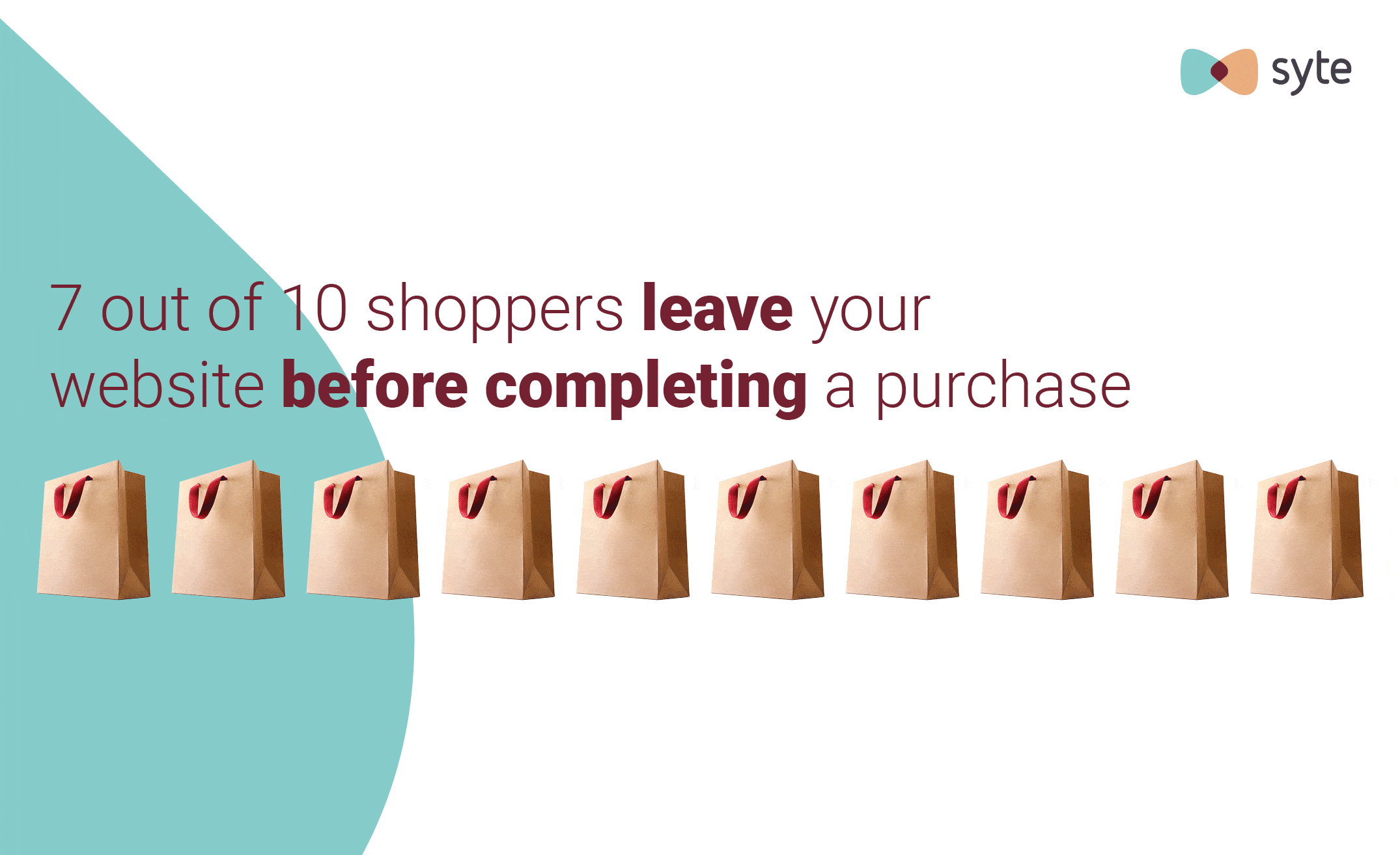
This is 1 of the most frustrating challenges for eCommerce brands and retailers. After yous successfully attract shoppers, inspire them with your inventory, and funnel them through the customer journeying, they bound transport right before converting. Simply don't lose faith! In that location are many tactics and strategies you can take advantage of to minimize your cart abandonment rate. In fact, Baymard estimates that online stores can increase their conversion rate by 35.iii% just through improving checkout pattern.
In this in-depth guide, we'll cover everything you need to know well-nigh the effects of shopping cart abandonment, why this result happens, and how to improve this crucial metric.
Shopping cart abandonment happens when shoppers add items to their cart but leave your site earlier making a purchase.
To calculate your cart abandonment charge per unit, you simply split the total number of completed purchases by the number of carts that were created. And then subtract this number from i and multiply by 100. For example, if you lot have 400 completed purchases from concluding week, but shoppers really created ane,000 carts during that time, your shopping cart abandonment rate is sixty%.
What Are the Negative Effects of Shopping Cart Abandonment?
A loftier shopping cart abandonment charge per unit imposes ii primary consequences for online brands and retailers. While one is more than obvious and has a articulate touch on on company functioning, the other tin however damage the brand. Permit's examine each of them.
1. Leaving money on the tabular array
I immediate consequence of cart abandonment is lost acquirement.
Let'south go back to the numbers nosotros used in the example higher up. Out of the 1,000 carts created per calendar week, just 400 shoppers consummate their purchase. That'southward a cart abandonment charge per unit of 60%. If the boilerplate society value (AOV) of each cart is $150, that means y'all're earning $60,000 in acquirement per week from the successful purchases. Even so, y'all are losing out on $90,000 per week from abandoned carts. That leaves a lot of money on the table—far more than you've actually earned. Annually, you are missing out on $4.7 million. This is huge!
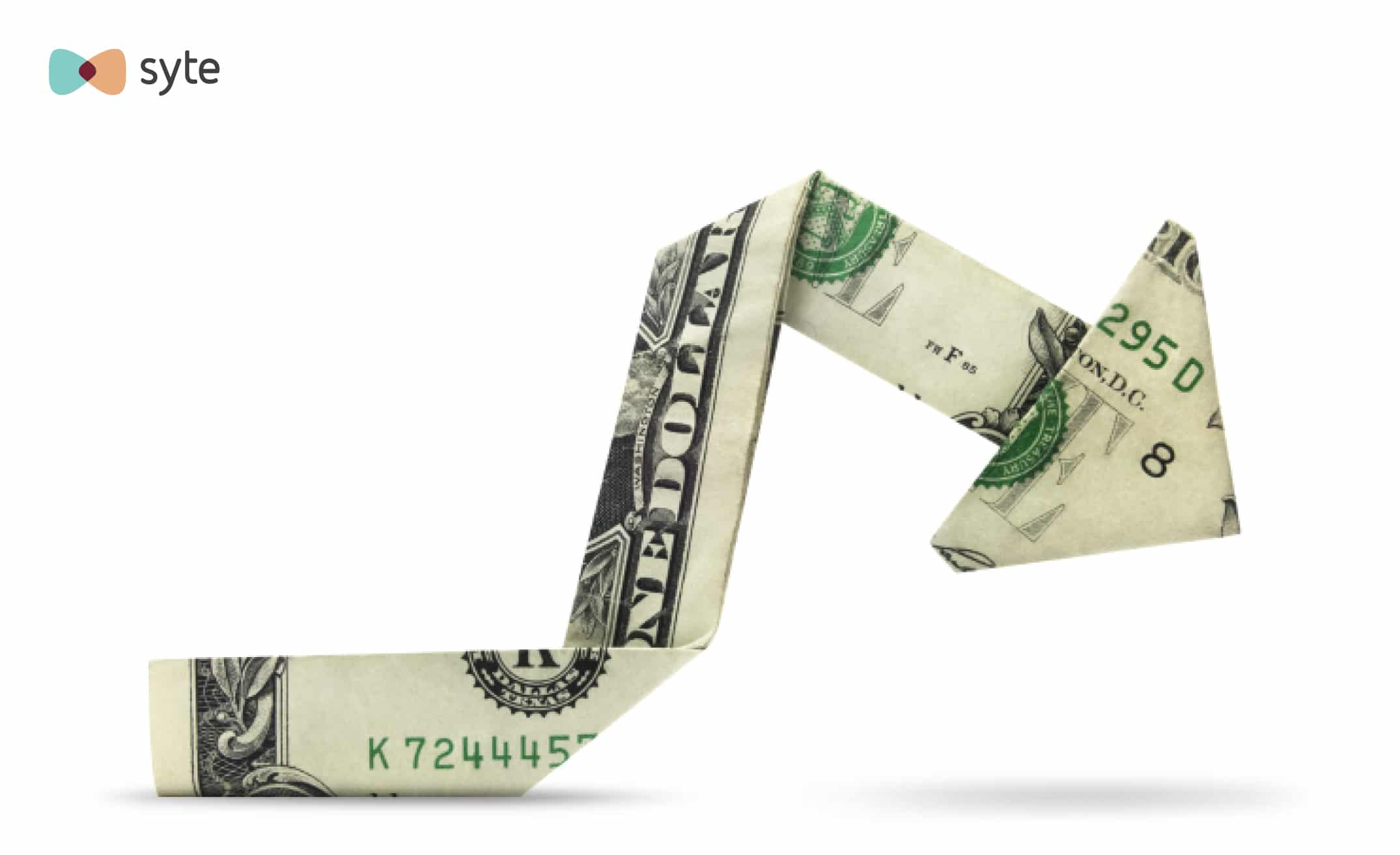
For nigh online brands and retailers, lost revenue is the most important upshot associated with shopping cart abandonment. Understandably, this is why they strive to understand why cart abandonment happens and how they can set up it. By lowering its occurrence, yous can recoup thousands or millions of dollars in could-be revenue.
2. Missed opportunities to build community and class relationships with shoppers
Today, community and client relationships are admittedly integral to make success. A positive online shopping feel helps companies to develop strong reputations, attract more than customers, and build brand loyalty.

Shoppers that decide not to buy the items in their cart won't post on social media about how much they love your brand, how great their feel was, how inspired they felt when perusing your inventory, or how that clothes they bought has become their new favorite item.
While the effects here may be less obvious than lost revenue, they are still significant. A cart abandoner won't get a brand administrator or recommend you to their friends. In the bigger motion picture, cart abandonment impairs your efforts to build community and increase brand loyalty.
Why Is Shopping Cart Abandonment a Problem for Retailers?
Beyond the obvious damaging effects mentioned above, shopping cart abandonment can highlight some other major issues. Here are iii of the nearly common concerns:
1. Poor UX at checkout
If many shoppers are dropping off when viewing their cart or in the center of checkout, it's a pretty articulate signal that something is wrong. In this instance, y'all need to exist asking a few different questions:
- Is the checkout process likewise long or circuitous?
- Are yous doing enough to assure shoppers that sensitive payment data is secure?
- Are you surprising shoppers with high shipping costs or an undesirable render policy?
Nosotros'll take a closer look at these obstacles (and more) beneath, but if there are UX-related issues then you lot have your work cut out for y'all. Gaining the trust of your shoppers, keeping their motivation to buy high, and making the checkout process as seamless as possible requires a shine, frictionless payment process.
ii. Shoppers are choosing to buy from your competitors
Although 31% of cart abandoners ultimately render to buy the items in their cart, 25% end upward buying them from a competitor. If y'all are losing shoppers to your competitors, especially at this point of the customer journey, information technology's of import to consider why that's happening. Here are a few possible reasons:
- The competitor is offering a better toll.
- Their checkout procedure is faster and easier.
- The competitor seems more than trustworthy and reliable.
- They offer faster shipping and a more than desirable render policy.
Information technology's difficult to pinpoint exactly what'southward driving private shoppers to your competitors, since you lot can't track them once they leave your site. However, by doing consequent research on your competitors, you can at least make an educated guess to try to reduce digital cart abandonment due to competition. For instance, imagine you are a home decor retailer in ane of the following situations:
- Seasonal markdown – You accept decided to mark down all of last season'south rugs by 15%. Nevertheless, i of your competitors marked downwardly many of the same rugs by 25%. If your shopper feels the urge to quickly compare prices before they complete a buy on your site, they volition undoubtedly buy the cheaper choice.
- Shipping costs – Your competitor offers free aircraft, but you don't. On the checkout page, yous include the aircraft cost of the carpet — which adds some other $40. Why would a shopper opt to pay more when they can get free aircraft from another store?
3. Difficulty refining personalization recommendations
One of the central types of data that personalization engines use to inform product recommendations is customer purchasing data. Although other on-site actions, such as liking an item, saving it for later, and adding it to your cart tin provide valuable insight on what customers like, the well-nigh influential data comes from completed customer purchases.
Shopping cart abandonment is a problem for retailers because information technology significantly reduces the amount of potential purchasing data. As a event, the quality of recommendations may not be optimal.
How Does Shopping Cart Abandonment Affect Inventory?
In that location are two main inventory-related concerns regarding shopping cart abandonment.
1. Stock level changes
One concern that many online brands and retailers have almost digital shopping cart abandonment is whether or not uncompleted purchases will affect their inventory calculations. For example, if a shopper adds five tabular array lamps to their cart, does the inventory management system reverberate a change? Will other shoppers be able to add together the same lamps to their carts?

Some eCommerce platforms don't let multiple customers to add the same exact product to their carts at the same time. However, the bodily stock levels won't exist affected unless a customer completes a purchase. So while your inventory might register that a shopper has added certain items to their cart, it won't prove that the detail's stock level has decreased until an actual purchase is made. If ii shoppers can't add identical items at the aforementioned time, this can exist extremely detrimental. What if the showtime shopper ends up abandoning their cart and your inventory software has prevented a more motivated shopper from completing a purchase?
For case, when you lot put an item into your cart on ASOS, the visitor puts information technology on hold for one hour. Think of this like property the clothes you want to buy in a brick-and-mortar store. Every bit you observe more items that you like, you pull them off the rack and concord onto them until yous try them on, buy them, or decide you don't desire them subsequently all. During this period of time, another shopper can't add together the same exact item into their cart (simply as they wouldn't come and take it out of your hands in the store). Nonetheless, subsequently an hr is up, that detail goes "back on the floor." By that time, a dissimilar, more motivated online shopper will already have moved on to another site.
2. Inventory relevance
Sometimes, shopping cart abandonment is a sign that your inventory needs some revamping. In other words, it'due south possible that shoppers abandon their carts because they've simply decided that they don't actually like or want the products y'all're selling.
Of course, brands and retailers don't have a way to know for sure if this is the reason, which makes it hard to larn how to improve product pick based on cart abandonment. On the other paw, analyzing the data of completed purchases informs brands and retailers how relevant a production is to their shoppers. A production that sells out in just a few days is conspicuously a hit. This tells yous to restock, increase your inventory, and make sure that you can encounter your shoppers' demands.
What Causes Online Shopping Cart Abandonment?
Online shopping cart abandonment occurs due to a wide range of factors. According to a survey by the Baymard Institute, the top 10 most prevalent reasons are:
- Extra costs are too loftier (shipping, taxes, fees) – 49%
- Completing a purchase requires creating an account – 24%
- Commitment is too slow – 19%
- Checkout process is too long or complicated – 18%
- Non trustworthy enough to enter credit card information – 17%
- Unable to see or calculate total order toll upfront – 17%
- Website had errors or crashed – 12%
- Unsatisfactory return policy – 11%
- Not plenty payment methods – seven%
- Credit carte du jour was declined – 4%
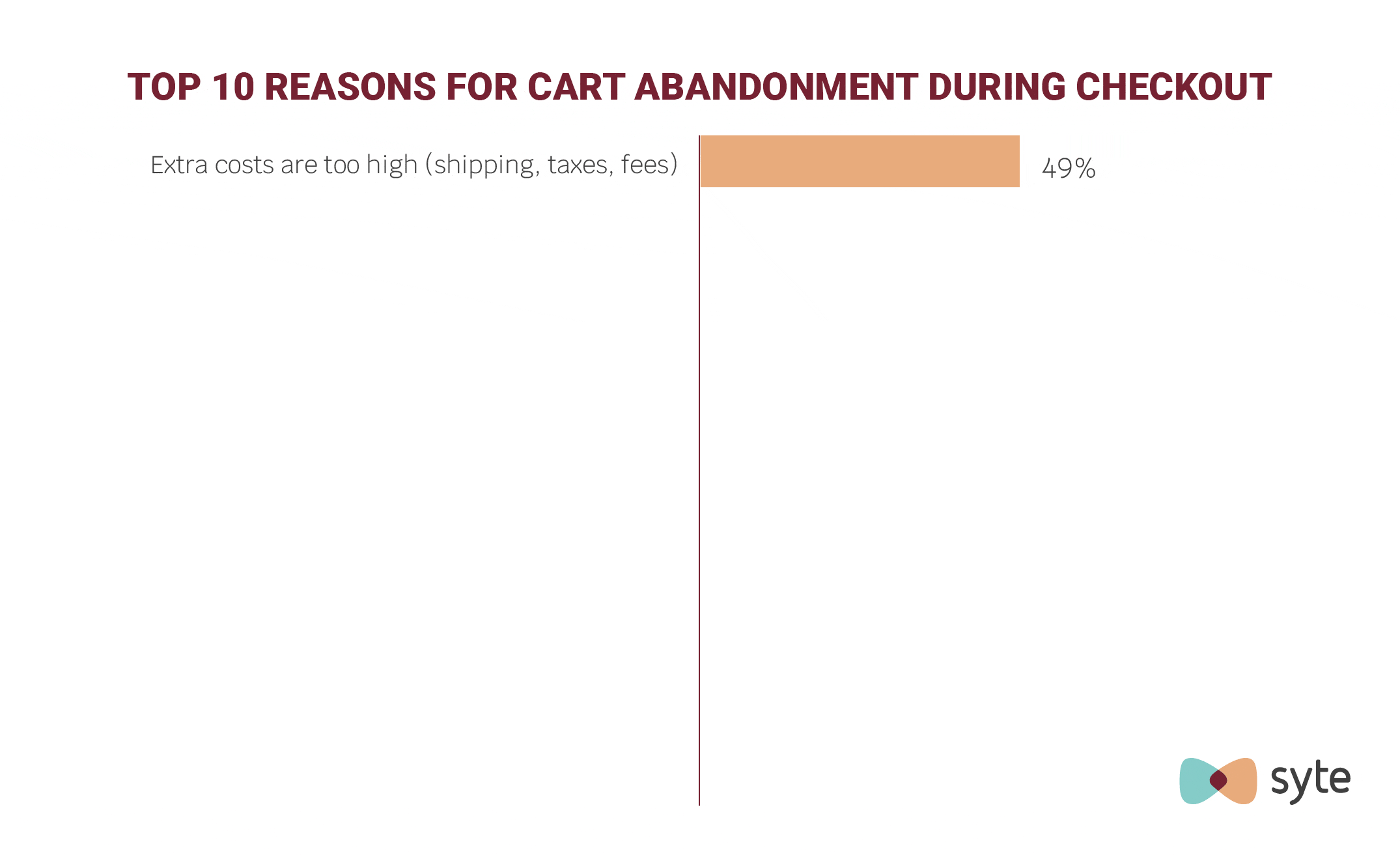
Some of these points are related to logistics or technology problems. For example, since the start of the COVID-19 pandemic, delivery carriers around the globe have been inundated with eCommerce shipping orders while simultaneously dealing with severe disruption to global supply chains. As a result, changing the speed of your delivery might exist difficult to reach or completely out of your hands.
Other bug—like your website crashing—might indicate there is something wrong with your digital infrastructure. Yet, this is something you lot tin and should deal with as soon every bit possible. One solution to consider is moving to a scalable cloud structure that can avoid server overload due to traffic peaks.
The rest of the problems listed above are preventable with meliorate UX and design. Here's a closer look at each of these obstacles.
1. Extra costs are too high or unlisted before checkout
This is a common issue that adds a lot of frustration to the customer feel and understandably drives shoppers to drib off earlier completing a purchase. When a shopper adds an item to their cart, it's condom to assume they already checked that item's price and are willing to spend that amount. But all of a sudden, once they are ready to pay, that price jumps up.
If you don't cistron in the costs of shipping, taxes, and other potential fees until the checkout page, you risk shocking the shopper with a pregnant increment. If the sum cost of all the items far exceeds what they are willing to spend, they are prone to non buy annihilation at all.
Imagine someone is gear up to spend $fourscore on a pair of jeans, but at checkout they see another $17 listed for shipping and taxes, bringing the total cost up to nearly $100. That might brand the jeans feel too expensive, leading to cart abandonment.
2. Completing a buy requires creating an business relationship
As the make or retailer, in that location are clear benefits to exist gained when users create an account. For example, it offers yous the chance to learn more about a shopper'south preferences and refine your personalization efforts. Also, when shoppers create an business relationship, they tin salvage their payment and shipping information, which makes shopping with you once more easier and more desirable.
However, not all shoppers are interested in these benefits. In fact, the added steps of creating a username and password and then needing to verify and remember this information can add besides much friction—enough to drive some shoppers away.
three. Checkout process is too long or complicated
The last time I went to the doctor's office, I had to fill out a tedious 4-folio class while I waited in the lobby. It took me x minutes to finish—far longer than the 5 minutes the doctor spent actually talking to me. This example mimics how shoppers experience when the checkout procedure includes multiple pages, also many fields, or requires excessive amounts of clicks. If the steps to complete a purchase feel too long or complicated, your shoppers may decide the item they are doing all of this piece of work for isn't actually worth it.
4. Payment security concerns

Trust is essential to eCommerce business success. Despite the fact that more people are shopping online now than always before, many people still have reservations near inbound their credit carte data online. In that location take been plenty of examples of breached client financial data, which puts many shoppers on edge. If your website doesn't appear completely secure, yous can lose a large portion of would-exist customers at checkout.
5. Unsatisfactory return policy
When people buy online, they know they are taking a risk. Whether information technology'south clothes, jewelry, shoes, or home decor, buying online doesn't give shoppers the chance to audit items in-person or try them on. That'southward why most people want the option of a full refund if they need to return what they ordered. Brands and retailers that limit returns or only allow for exchanges or store credit run a risk driving shoppers away. Those that simply inform shoppers of their return policy on the checkout folio are at fifty-fifty college risk for digital cart abandonment.
half dozen. Not enough payment methods
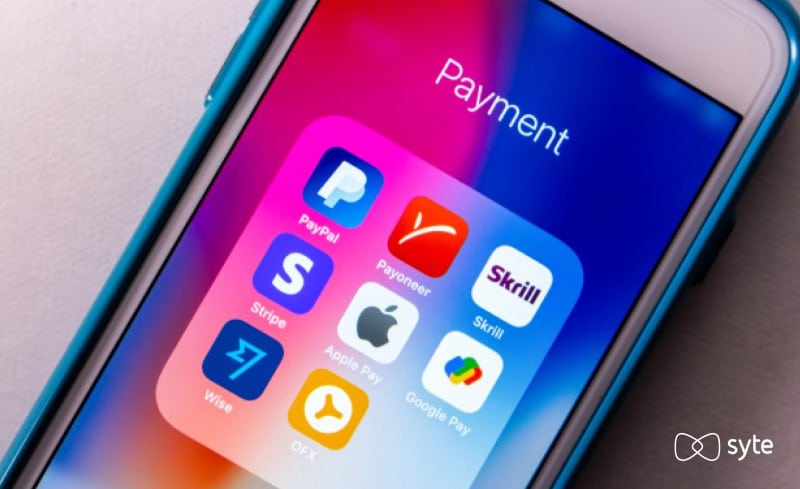
In the commencement of the online shopping era, paying with a credit card was the only option. Today, that's no longer the case. Many shoppers now prefer alternative payment methods that offer greater convenience or security. For example, some people prefer PayPal or Google Pay, since their credit carte information is already saved and secure in these platforms. Others want the option to purchase their cart with multiple installments. If you don't make the payment process easy and seamless, shoppers can jump transport and find a different brand or retailer that does give them options.
seven. Website had errors or tedious load times
If your website appears unstable or takes as well long to load each page, shoppers may get frustrated or lose conviction in your checkout process. Many customers volition be reluctant to re-enter payment information if your site crashes and reloads because they will be worried about getting charged twice. Instead, they'll play it condom and abandon their cart.
How to Reduce Shopping Cart Abandonment: 8 Strategic Tips
Now that we've covered the causes and effects of digital shopping cart abandonment, allow'due south go over eight proven tips for reducing it.
ane. Amend your mobile checkout experience
Almost three-quarters of all eCommerce purchases (72.nine%) occur on a mobile device, according to Statista. At the aforementioned fourth dimension, mobile devices are also responsible for the highest rate of shopping cart abandonment (74%) compared to other channels (62% on tablets and 61% on PCs). Since mobile shoppers represent the largest share of all eCommerce consumers and they carelessness their carts at the highest rate, improving the mobile feel tin can go a long way.
To remove friction and improve UX, focus on how the checkout menstruation looks and functions on a smaller, mobile screen — and recollect that simplicity and speed are primal. Here are some important questions to consider:
- Do yous require shoppers to tap on and fill in numerous pocket-size fields on each page of the checkout process?
- Do y'all include too many pages, with boring load times in between each ane?
- Can shoppers view and edit their carts along the way, or practise they demand to printing "back" in order to make a change?
- Is pertinent information clear? For example, do you identify costs, promotions, your return policy, and estimated delivery date upfront?
ii. Reduce complexity and minimize clicks
This tip is pertinent for reducing shopping cart abandonment on all devices. By making the checkout procedure as short, straightforward, and quick as possible, you will subtract the chances that shoppers will become annoyed and quit in the middle.
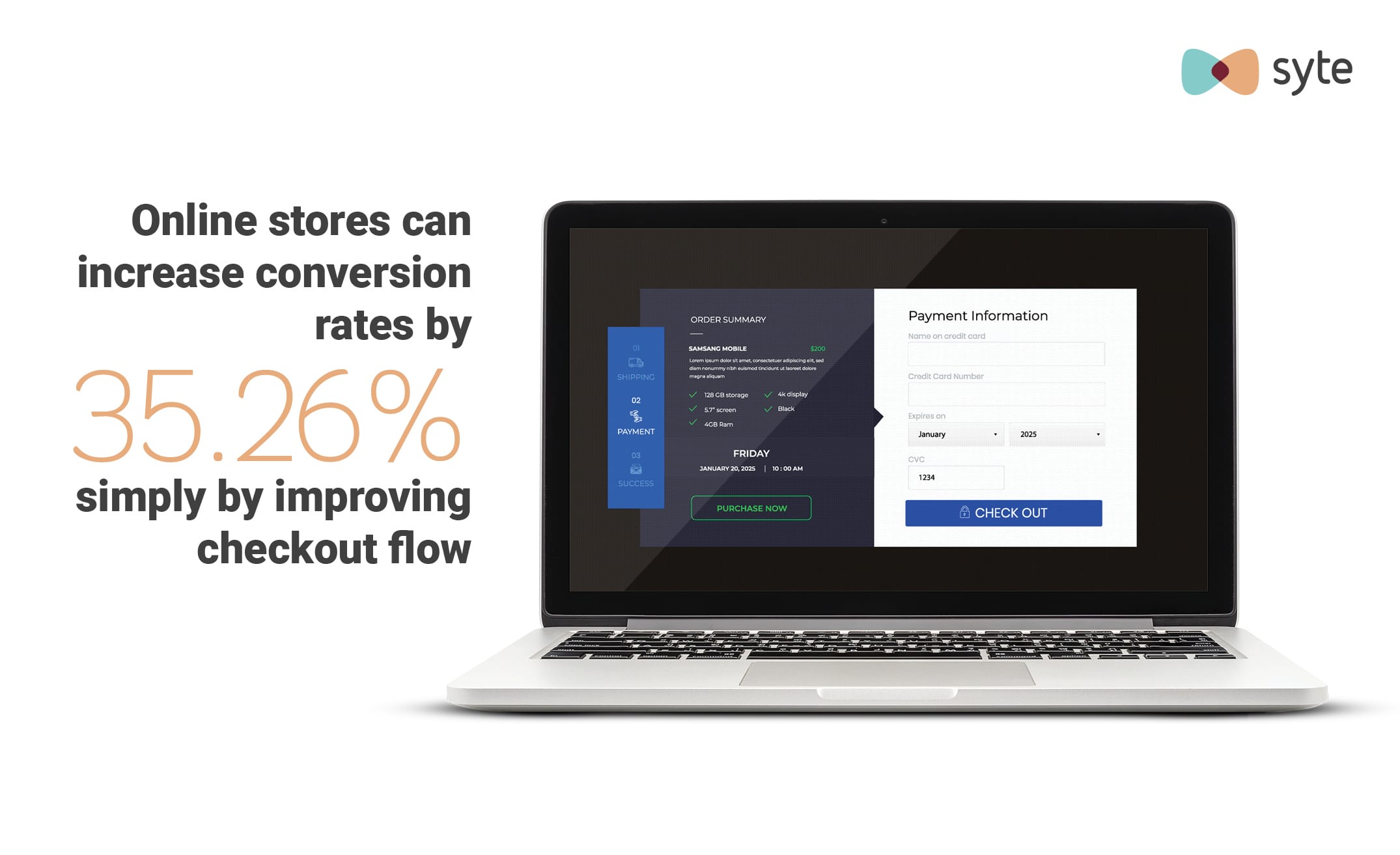
According to the Baymard Establish, an average large-sized eCommerce brand or retailer tin can boost their conversion charge per unit by 35.26% with amend checkout flow. This translates to recovering billions of dollars of lost orders worldwide. That makes it extremely worth your while to consider which aspects of your checkout process can be shortened. Here are a few examples:
- Only include necessary fields. If you lot don't need a certain piece of data in lodge to execute the transaction, then checkout is not the place to inquire for it. For example, don't ask the shopper to charge per unit their experience on your website earlier they complete the payment or endeavour to become them to subscribe to your newsletter. All of that should be optional, and occur afterwards the payment is completed.
- Don't require shoppers to create an business relationship. Instead, give shoppers who don't take an business relationship the option to check out as a invitee. This tin assistance people who are in a hurry to quickly go through the process without having to create an account and verify their information.
- Don't list any unrelated production recommendations. While including last-infinitesimal recommendations on the cart page might nudge some shoppers to add another item to their order, this tactic can likewise backfire if yous're displaying random or unrelated product images that tin can distract them and cause them to veer away. Instead, make sure to be super targeted and on indicate with whatsoever product recommendations on your checkout page — and enable shoppers to quickly add together these items to their cart without having to leave the checkout page to select their size and color preferences.
- Let shoppers to save checkout data. Some shoppers volition desire to salvage their shipping, billing, and credit menu data when given the option, as this allows them to speed upwards the checkout process in future sessions.
3. Increase trustworthiness
Customer trust is imperative to conversion and the evolution of a strong community of shoppers. If lack of trust is contributing to shopping cart abandonment, it'southward fourth dimension to reexamine your payment security.
Kickoff, make certain your technical infrastructure is PCI DSS compliant (Payment Bill of fare Manufacture Data Security Standards) and equipped with fraud prevention tools. We too recommend including recognizable payment security symbols and badges on the checkout page. Seeing these helps to remedy reluctant shoppers' concerns.
Yous can also employ social proof to eternalize customer trust. Past displaying user-generated content, client reviews, and ratings on your site, you volition show new shoppers that many others have successfully and safely bought products from your site. Social proof tin can assist validate your brand in the eyes of consumers, and motivate them to convert.
4. Accept a variety of payment methods
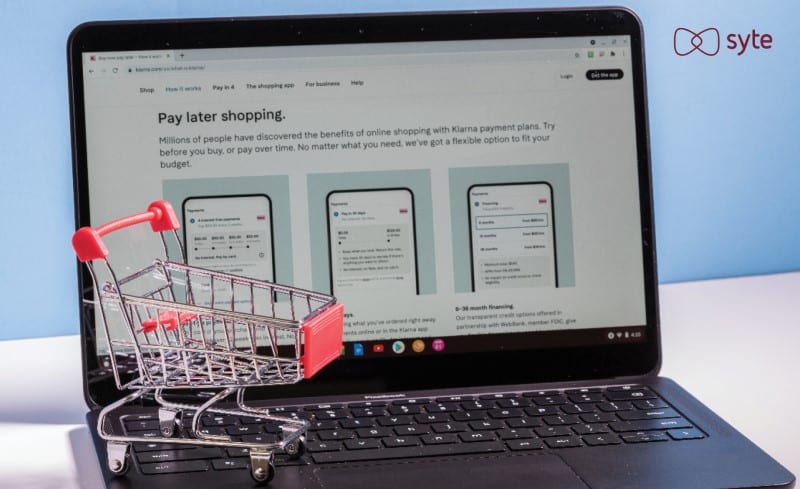
Consumers today bask numerous ways to admission and spend their money. Past providing shoppers with the ability to choose the method that feels the safest, fastest, and nearly convenient to them, you lot will make checking out easier and more attractive. Here are two payment options you lot tin can add together to your site:
- Shopping apps or digital wallets – Shoppers who don't want to pay with credit cards might adopt to use shopping apps or digital wallets, such as PayPal, Venmo, Store Pay, Apple tree Pay, Samsung Pay, or Google Pay.
- Buy at present, pay later (BNPL) services – According to CB Insights, Americans spent an estimated $20 to $25 billion using BNPL services in 2020. Globally, deferred payment purchases are expected to top $1 trillion by 2025. Adding this pick to your eCommerce site not only caters to consumers' desires for culling payment methods, it likewise enables you to boost AOV. Some retailers have reported AOV increases of xx% to xxx% after adding BNPL services. Examples of some high-demand BNPL options to consider include Klarna, Four, and AfterPay.
v. Analyze pertinent information early
Shoppers don't enjoy being surprised at the checkout page with information related to shipping costs, delays, or returns. Although you lot may not call back that advertising your "no refunds" policy will help catechumen more customers, it's always better to inform shoppers upfront about these details. Waiting to clarify this information at checkout could drive many shoppers away.
The get-go style around this is to provide more competitive offerings, such equally the ability to return items for a full refund and free aircraft. However, sometimes, this just isn't possible. In those cases, it'southward best to inform shoppers earlier in the journey. For example, yous can add a widget to your site that asks shoppers to confirm their location, and and so provides an estimated shipping fee. It's also advisable to publish your return or exchange policy on PDPs, and then shoppers know what they are getting into before they add together an item to their carts.
vi. QA again, and again (and again)
We know that buggy or boring load times can contribute to digital shopping cart abandonment. That'southward why routine, consistent quality balls and usability testing are essential. After calculation new features, updating your inventory, or changing any aspect of the checkout flow, brand sure you perform careful QA to make sure the procedure flows smoothly. This includes not one, but multiple rounds of testing to achieve the best UX.
In the end, many website bugs or crashes can be avoided with more than attentive maintenance — so take the time to do your QA critically and oftentimes in society to give your shoppers the all-time feel on your site.
7. Brandish cart sum total with every add-on
Each time a shopper adds another product to their cart, it's best to display the items they've added so far, as well as the sum total. This helps them avoid feeling shocked when they come across the price of their cart at checkout, which sometimes drives shoppers to driblet off.
viii. Follow-up with shoppers who abandon their carts
It's possible that a shopper abandoned their cart because they had reservations or concerns about the production/southward — or perhaps they simply got distracted. By following upwards with cart abandoners and reminding them of the products they left behind, you can nudge them to go back and brand a purchase.
Research shows that retargeting shoppers with ads can reduce cart abandonment by half dozen.5%, and increase online sales by almost 20%. Emails are too an effective way to bring back cart abandoners. According to 99 Firms, cart abandonment emails have an open rate of 41.1%.
Minimize Shopping Cart Abandonment
There are numerous strategies you tin can have advantage of to reduce digital shopping cart abandonment. The all-time approach is to cast a wide internet—identify as many factors for cart abandonment as yous tin can, and work to address each one of them.
While external marketing efforts, such as ad campaigns, influencer partnerships, and collaborations tin can be a boon to sales and branding, few strategies will accept as big of an impact as finding ways to convert shoppers who have already fabricated it to the end of the client journey on your site.
Source: https://www.syte.ai/blog/ecommerce-trends/reduce-shopping-cart-abandonment/
0 Response to "How to Upload Picture of Person Abandoning Shopping Cart in My Property"
Enviar um comentário